Orion Introduction
Accessories
![]() News
News ![]() Products
Products ![]() Pricing
Pricing ![]() Distribution
Distribution ![]() Notes & Interesting Articles
Notes & Interesting Articles
![]()
![]()
![]() Mounts
Mounts
![]() Telescopes
Telescopes
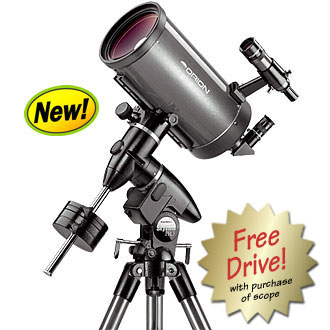
![]()
SkyView Pro™ 150mm (6 inch) Maksutov-Cassegrain Telescope
Right: SkyView Pro™ 150mm (6 inch) f/12 Maksutov-Cassegrain Telescope with furnished SkyView Pro™ Orion German Equatorial Mount. Optical tube available separately. (28,532 Bytes)
-
"after you've been frustrated by poorly working, less reliable "go to" telescopes that get in the way of your observing experience then maybe you'll discover the rewarding simplicity and high value of this telescope"
Introduced in the Fall of 2005, the Orion SkyView Pro™ 150mm is recommended by Company Seven to those who seek a high resolution, multi-purpose, lightweight and compact telescope for astronomy. The SkyView Pro™ 150mm is an arrangement similar to its smaller, highly successful cousin the StarMax 127™ 5 inch Maksutov-Cassegain telescope that was introduced in the Fall 2001. With a 30 per cent increase in light gathering power and a 1.2X increase in resolution over the StarMax 127™, the 150mm brings one into the realm of much more serious astronomical capabilities. And with the more rigid provided SkyView Pro™ German Equatorial Mount this 150mm system is very well suited for those with a more than casual interest in astronomy and who seek memorable views of the brighter objects (planets, moon, Sun, and brighter deep sky objects.
The SkyView Pro™ 150mm is truly more reliable and well supported by the provided motorized SkyView Pro™ German Equatorial mount and tripod. The German mount is a somewhat bulky and initially awkward platform for the novice, but this one is a reliable and stable platform that adds only moderate cost with great capability to the package. This system, when mated to any of a number of optional economical CCD imaging cameras which we offer can provide images of planets and deep sky objects that one would be proud to frame and hang on the wall. Of course, it is possible to buy the 150mm telescope optical tube assembly without mount if you wish to employ it onto another platform. The 150mm optical tube assembly (OTA) at 17 inches in length and 7-3/8 inches wide is so compact that it can be carried about and employed in the field for long distance terrestrial uses of nature watching and photography.
All of this is provided for a relatively modest cost since the complete SkyView Pro™ 150mm system is notably less costly and yet more capable than any of the ubiquitous and comparatively less reliable tabletop compact "go to" telescopes on the market today. In fact we at Company Seven have periodically evaluated a number of the popular "go to" Mak-Cass telescopes available in apertures up to 5 inch, but none have been consistently good and reliable by our standards. And after you've been frustrated by poorly working, less reliable "go to" telescopes that get in the way of your observing experience then maybe you'll discover the rewarding simplicity and high value of this telescope.
The Orion 150mm Mak-Cassegrain proves to be a capable performer, well suited for uses on objects that can be seen from suburban skies. However, for customers whose interests lean more towards deep sky observing, particularly from darker sky sites, then Company Seven continues to recommend our Orion SkyQuest™ and Intelliscope™ series Dobsonian style "light buckets".
What we mentioned in our review about the StarMax 127™ also applies to this 150mm:
-
"The real surprise to Company Seven and to our customers has been how disproportionately better than its' price this telescope performs! One simply does not expect to find this good a combination of performance, adequate mechanics, and professional appearance in any rather complicated to make Catadioptric compact telescope. Much less one that includes a really adequate German Equatorial mount too."
The SkyView Pro™ 150mm is among the few economical multipurpose portable telescopes that we enthusiastically offer. With 6 inches of light gathering power providing an improvement of about 330X that of the human eye, and good overall optical quality this is a capable high resolution telescope for astronomy. Being a closed Maksutov-Cassegrain design it is relatively lightweight, compact, rugged, and simple to maintain. The nice fit and finish, and feel of the focuser are uncommon in a telescope so moderately priced too! Included is a 25mm Plossl eyepiece (62X 0.73 Degree Field of View), lightweight carrying bag, and to permit the easy tracking of celestial objects across the sky - an easy to use German Equatorial Mount (clock drive optional). This telescope is a particularly good choice for those in suburban settings who want to glimpse changing features on the brighter astronomical objects, or for nature watching, etc. The telescope can be easily dismounted for use as a spotting telescope or as a 1,800mm ultra telephoto lens. And there is nothing to stop one from swapping out one telescope for another on the SkyView Pro™ mount since it relies on quick release hardware to attach telescopes onto the mount head.
History of the Mak-Cassegrain: The component that defines the Maksutov telescope is the relatively thick deeply curved "Meniscas" corrector lens which reduces spherical aberration, a spherical Primary Mirror (usually about f2), and a convex Secondary Mirror (usually an aluminized spot on the Corrector Lens) which imparts magnifications of about 5X. The "Meniscas" corrector was the brainchild of two men, working independently and separated by a War. In 1941 A. Bouwers of Amsterdam, Holland and Dimitry Maksutov in Moscow, Russia were each trying to develop an alternative to the more difficult to fabricate thin Schmidt-Corrector. The Schmidt Corrector is a thin aspheric lens developed by Bernhard Schmidt in the 1920's for use in the astrographic "Schmidt Cameras" made by Carl Zeiss company in Germany. Both men arrived at about the same conclusion but since by 1944 Maksutov had published the design, history associates the lens with his name. This new lens was used to produce a compact and rugged Catadioptric (mirror and lens system) telescope. The Cassegrain aspect describes the perforated primary mirror permitting the focal plane to reach the rear of the telescope. The Meniscas Corrector and Cassegrain configuration would become known as the Maksutov-Cassegrain.
The Maksutov-Cassegrain was first popularized in the early 1950's in Lawrence Braymer's Questar 3-1/2 and later 7 inch telescopes. When properly made, these provide views very similar in detail and clarity to the finest similar aperture apochromatic refractors, yet about 1/3 or less the physical length of the typical refracting telescope. Having f ratios of f/14 or longer the Maksutov-Cassegrain lacks the versatility of the Apo refractor since the field of view and photographic possibilities are comparatively limited.
In early 2001 Company Seven chose to ally ourselves with Orion Telescopes and Binoculars in order to provide to our customers an increased measure of proven reliable supply, customer service, and another notch of influence on quality control. In August 2001, the StarMax™ 127 became the first moderately priced Maksutov-Cassgrain telescope suitable for astronomy that Company Seven chose to offer.
to offer these telescopes, and our customers have not been disappointed.
WHAT DOES IT DO? The SkyView Pro™ 150mm provides astonishing views of many objects. The moon appears as though you are orbiting it. While Venus, Mars, Jupiter and Saturn are clearly identified each revealing their major changing features through out the observing seasons. In fact this among our least expensive telescopes with an equatorial mount that can clearly show the Cassini Division in Saturns rings. The rugged optical design is apochromatic (showing no false color), optimized for visual use. The contrast and apparent brightness will outperform most common 4 inch aperture achromatic refractors (not that many outstanding ones remain in production), and it can surpass several other more expensive telescopes, and the views of some objects may appear similar to small (3.5 to 4") Apo refractors! Viewing the moon you may imagine you are seeing details as if you were in orbit even though the smallest object you could see with this telescope will actually be about 3 kilometers in diameter. With an optional solar filter you may observe sun spot activity, or an eclipse. While for viewing deep sky objects (galaxies, nebulae, star clusters, etc.) we generally prefer telescopes with more light gathering power and 2 inch eyepiece capability such as the Orion 8" f6 or its larger cousins, this manageable telescope has such decent optics and good contrast that it can reveal a number deep sky objects nonetheless. The light gathering power and contrast will make hunting the deep sky objects rewarding. And with its increased light gathering power over its smaller cousins, the 150mm shows real benefits when equipped with optional light pollution rejection filters; one could even employ an optional Oxygen III filter with the 150mm and go after many nebulae including the Dumbell and the Ring. Star clusters will appear three dimensional with stars floating as salt particles against a black background. The "Double Double" is clearly resolved.
With an optional camera adapter this 150mm Mak may be used as a 1,800mm f/12.1 ultra-telephoto lens for photography with common 35mm SLR film and digital cameras, or for CCD imaging with a number of compatible cameras.
Those telescopes passed by our quality control testing reveal a thick, durable Corrector Lens that is beautifully multi-coated on both front and rear surfaces with spotlessly clean primary and secondary mirrors. Those who like to play "telescope testing" are likely to be pleasantly surprised at the Airy disk and diffraction ring patterns appearing distinct and nearly symmetrical in and out of focus, with no signs of zones or roughness - tell tale signs of patient and professional mirror making.
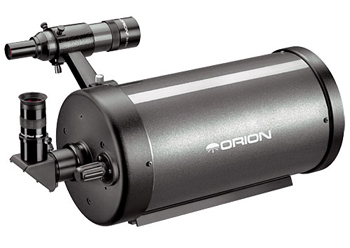 Right: 150mm f/12 Mak Cassegrain Optical Tube Assembly as provided with the SVP package (42,731 bytes).
Right: 150mm f/12 Mak Cassegrain Optical Tube Assembly as provided with the SVP package (42,731 bytes).
Click on image to see enlarged view (73,331 bytes).
Noteworthy features of the SkyView Pro™ 150mm Maksutov-Cassegrain telescope:
- Silky focuser provides transiting Primary Mirror controlled by manual lead screw drive
- Fine Annealed Pyrex Primary Mirror for better thermal stability
- Fine Annealed Borosilicate Crown Corrector Lens
- Fully Baffled
- Rugged, permanently aligned optics provide complete freedom from concerns of collimation (Primary Mirror is adjustable if ever needed)
- Corrector Lens fully Multi-Coated
- Durable protected aluminum reflective mirror coatings
- Optics very smoothly polished
- Professional, dark silver metallic painted finish
- Mounting Plate (secured by two M6-1 x 20 bolts) provided with two 1/4"-20 threaded holes to attach telescope to German mount, or onto optional photo tripod
- 8x 40mm Finder, in line view with Quick Release Bracket with two-screw X and Y axis alignment
- 1.25" Mirror Diagonal, 90 Degree (image erect but reversed left to right)
- Orion "Sirius" series 10mm (180x) and 25mm (72x) Plossl Eyepieces
- Orion illustrated instruction manual (available in ".pdf" format from Company Seven's Library.
This is a telescope that is ready to go out of the box, and for the price most people have come to agree the optical tube alone is worth that or more! However, owners are likely to accessorize it a bit better to make it more versatile or better able to keep their interest in a variety of applications. For example:
- upgrade the 40mm finder to either a Telrad or Rigel QuikFinder illuminated sight, or correct image right angle 50mm Finder
- those interested in the most clear images may upgrade the provided mirror diagonal
We also suggest a suitable carrying bag or padded case; one is not yet offered by Orion. Most of our customers will benefit from an optional Lens Shade/Dew Shield and possibly even a regulated electronic dew and frost prevention accessory such as those by Kendrick which we stock.
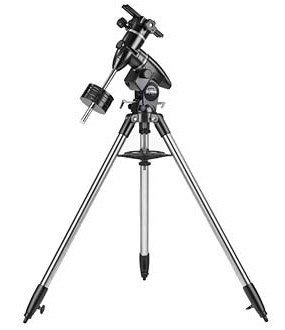 Right: Click image if you wish to take a 360 degree tour of the SkyView Pro™ 8 telescope which includes the SkyView Pro™ mount.
Right: Click image if you wish to take a 360 degree tour of the SkyView Pro™ 8 telescope which includes the SkyView Pro™ mount.
This is a Macromedia Flash presentation, and so your Web Browser should be enabled to view it (163,690 bytes).
SkyView Pro™ Equatorial Mount Highlights
- Completely adequate, solid performance
- Adjustable yet smooth friction/drag clutch on each axis
- 3.4 inch (86 mm) Diameter Setting Circles in R.A. and Declination help one find their way around the night sky,
and learn how use the celestial coordinate navigation system developed for astronomy - Fine geared controls in elevation and azimuth to facilitate a more accurate Pole Alignment
- Fine geared manual slow motion controls for Declination and Right Ascension
- Adjustable height tripod with 2 inch diameter stainless steel tube legs, provides Mount Saddle Height range adjustment from about 42 to 61 inches
- Tripod constructed of durable aluminum castings with 2 inch diameter steel tube legs
- Tripod Leg length locking Hand Knobs are positioned inside of leg spread to reduce possibility of breakage, or of tripping the user
- Setting circles in Declination and Right Ascension
- Quick Release Dovetail Saddle Plate accepts telescopes with Dovetail Bar (Bar provided attached to the 150mm OTA)
- Spreader Bar incorporates Eyepiece Holder for 1.25" and for 2" eyepieces or accessories
- Clamp Style Mounting Rings with easy to operate Hand Knobs
- Piggyback Astrophotography Bracket conveniently provided on top of Mounting Ring
- Thread on Counterweight Shaft with Safety Stop
- Two Counterweight included to balance telescope even with most common optional accessories: 4 lb (1.8 kg) and 7.5 lb (3.4 kg)
- Extra Counterweights are available.
- Eyepiece height ranges from 48 inches, up to 57 inches (121 cm to 145 cm) with tripod legs extended
- Wrench provided to tighten tripod bolts
- optional Pole Alignment Telescope available
SkyView Pro™ Equatorial Mount Drive Systems (customer's choice of Dual or Single Axis)
- Stepper Motors with Drive Corrector - permits completely automated tracking of celestial objects
- Push Button Hand Held Drive Controller with slewing speeds of 2x, 8x, and 16x Sidereal Rate
- Drive can track in either North or Southern Hemispheres
- Declination and Right Ascension control button reversing switches to maintain a comfortable orientation
when making drive corrections while pointing to all quadrants of the night sky - Battery Pack Provided, accepts eight "D" cell alkaline batteries, or 12 volt D.C. rechargeable pack for operation in the field from provided battery pack
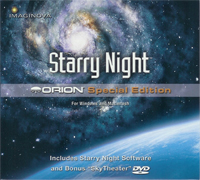 Receive a FREE Starry Night Special Edition software suite. Both the highly acclaimed planetarium software by Imaginova "Starry Night Special Edition" with a bonus "SkyTheatre" DVD are included FREE with purchase of any Orion-brand astronomical telescope from Company Seven.
Receive a FREE Starry Night Special Edition software suite. Both the highly acclaimed planetarium software by Imaginova "Starry Night Special Edition" with a bonus "SkyTheatre" DVD are included FREE with purchase of any Orion-brand astronomical telescope from Company Seven.
"Starry Night Special Edition" is a basic version of the more capable "Starry Night" version 5.0 astronomy software series; this software will help you learn the night sky, see what is up day or night, now or in past millennia, plan your observing sessions, and print out charts and information about the celestial wonders. The set also includes "SkyTheatre", a DVD by Imaginova so your television or PC becomes a spaceship on a voyage through our Solar System. The set is compatible with both Macintosh computers running OSX version 10.3 or later, and with Windows XP for PC. Your personal planetarium and guide to the night sky!
Left: CD-ROM "Starry Night Special Edition" with bonus "SkyTheatre" DVD suite (43,322 bytes).
Click on image to view enlargement (85,180 bytes).
FURTHER READING
![]() To read about the Orion SkyView Pro™ German Equatorial Mount download "Orion SkyView Pro™ 8 EQ Telescope Instruction Manual". Complete 20 page illustrated instruction manual as furnished with our Orion SkyView Pro™ 8 EQ Equatorial Reflecting telescope. Publication content by Orion Telescopes and Binoculars, all rights reserved. From Company Seven's Archives. 2,061,695 bytes (in Acrobat Reader ".pdf" format).
To read about the Orion SkyView Pro™ German Equatorial Mount download "Orion SkyView Pro™ 8 EQ Telescope Instruction Manual". Complete 20 page illustrated instruction manual as furnished with our Orion SkyView Pro™ 8 EQ Equatorial Reflecting telescope. Publication content by Orion Telescopes and Binoculars, all rights reserved. From Company Seven's Archives. 2,061,695 bytes (in Acrobat Reader ".pdf" format).
TELESCOPE SPECIFICATIONS
| Optical Tube Specification | |
|---|---|
| Clear aperture: | 150.5mm (5.9 inches) |
| Effective Focal length: | 1,800mm (70.9 inches) |
| Secondary Obstruction: | 52.6mm (2.07 inch) |
| Corrector: | Borosilicate Crown (BK-7) |
| Primary Mirror: | Glass, fine annealed |
| Corrector Lens AR Coatings: | Multi-layer |
| Mirror Reflective Coatings: | Enhanced aluminum, SiO2 overcoated |
| Central Obstruction: | 12 per cent by area |
| Resolution (visual): | 0.77 arc seconds |
| Resolution (photo): | 0.37 arc seconds |
| Useful Magnification Range: | 45x to about 350x |
| Prime Focus Photographic Field of View (35mm) | 1.1 x 0.8 degrees |
| Tube assembly construction: | Seamless aluminum tube, aluminum front and rear cells |
| Focus Arrangement: | Transiting primary mirror. Rubber covered aluminum focus knob. |
| Near Focus: | About 15m (50 feet) |
| Telescope length: | 42. 5cm (16-3/4 inch) |
| Weight of OTA with Finder: | 5.6 kg (12-1/4 lbs.) |
| SVP Mount Specification | |
|---|---|
| Tripod Height Minimum: | 32 inches (81 cm) |
| Tripod Height Maximum: | 40 inches (102 cm) |
| Equatorial Head Weight | 23 lbs. (10.5 kg) |
| Overall Dimensions | |
|---|---|
| Overall Weight | 23.4 kg (51.4 lbs.) |
| Shipping Weight: | 30 kg (66 lbs.) |
| Packaged Dimensions: | 121 x 51 x 30.5 cm (48 x 20 x 12 inch) |
* Specifications are subject to change without notice. Shipping dimensions do not include Drive Systems, or other added accessories.
Upon arrival, each telescope is assembled, inspected, and star tested by Company Seven's experienced staff prior to acceptance. The telescope is usually delivered to our customers in it's cardboard packaging since assembly is a fairly simple matter. While delivery is available and the telescope is fairly well protected by the double boxing, there is always some risk of damage in transport and so we suggest pickup in our showroom when practical. You may later choose to attend our complimentary course of instruction. And of course the Orion One Year Limited Warranty is complimented by Company Seven's own guarantees and service facilities. With proper use and maintenance, there is very little that can go wrong with a telescope such as this - if there is a problem then it is likely we will have found it for you and so with the exception of mirror coatings, Company Seven backs our telescopes for life.
SUGGESTED ACCESSORIES
These are optional accessories that are not included with the telescopes that we highly recommend for your viewing pleasure and long term success:
- Dew Shield/Lens Shade
- Guide book: "Backyard Astronomers Guide" or "Nightwatch" by Terrence Dickinson, or "Starware" by Phil Harrington. For the novice from age 8 to 15 or so up to adult. Good introductions to astronomy, the use of telescopes, and their accessories. Easy introductions to finding ones way around the night sky.
- Telrad or Rigel QuikFinder illuminated sight: to aid one in finding and centering objects in the main telescope, and learn the sky by "star hopping" from one object to another
- The
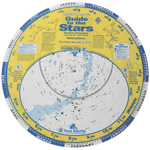 David H. Levy Guide to the Stars Planisphere If you are not familiar with the night sky then Company Seven recommends you buy a good simple Planisphere which makes it very easy for one to find out what constellations and major deep sky objects are overhead at any given time of the day or night.
David H. Levy Guide to the Stars Planisphere If you are not familiar with the night sky then Company Seven recommends you buy a good simple Planisphere which makes it very easy for one to find out what constellations and major deep sky objects are overhead at any given time of the day or night.
The night sky is mapped with the Constellations being those patterns recognizable to man since time immemorial. Constellations can be thought of as countries or states on a world map, where if you seek the Grand Canyon then you know to find Arizona. While in the night sky when one seeks the Great Nebula then one looks toward the Constellation Orion. The Planisphere is a two piece assembly consisting of one disc with a chart of the entire night sky, and an attached overlay disc with a transparent window and surrounding mask to simulate the horizons. The overlay is dialed to line up its local time indicator marks with the Month and Day printed around the edge of the chart disc, and so when properly set this will reveal what parts of the sky may be seen at any time of the year. The print is easy to read under day or red light.
- Red LED Flashlight such as the Rigel Skylite to help one set up and use a telescope, and to read charts or a planishpere without adversely impacting the observers night vision.
- Neutral Density and Color Filters to reduce the brightness of the Moon and Planets, and highlight subtle features.
- Solar Filter: Orion fitted glass model, or Baader Astro-Solar polymer to observe sunspots, and solar eclipses.
- Sky Light Pollution Rejection Filter to reduce the greenish or golden background glow from city lights and darken the sky background - aid seeing faint Nebulae.
- Mirror Diagonal: 1.25" diameter precision mirror to improve quality of view.
- Eyepieces: The eyepiece is the lens which is put into a focuser to magnify the image provided by the telescope. Proper choice of eyepieces can make or break a telescope. Typically astronomers will wish to initially set up the telescope with at least two or three eyepieces. The goals will be to address:
- Low magnification: for views of the faint deep sky objects: 32mm to 40mm focal length eyepiece.
- Middle Magnification eyepiece - usually between 80 to 120X, for views of
the full Moon, Star Clusters, etc.
- High magnification: 200X or more for views of the planets.
Note: For undistracted observing at above 200X, or for simple astrophotography we suggest use of the provided Clock Drive. This is a battery powered motor that will permit the pole aligned mount to track objects across the sky automatically. Available in customers choice of either Single Axis or Dual Axis configuration.
Relatively simple eyepiece designs such as the Plossl, Orthoscopic, traditional Erfle and some other wide angle eyepieces can show sharp clear images across the field of view with telescopes such as this. These can be quite acceptable and provide reasonably wide field of views and good eye relief down to focal lengths of about 10mm or so. Company Seven also offers the Orion Ultrascopic Plossls which provide excellent image quality, and good eye relief at relatively modest cost.
If you require even more eye relief, then Company Seven recommends more advanced designs such as those pioneered by Al Nagler, founder of the TeleVue company. TeleVue's designs include the "Radian" which provide excellent 19 to 20mm eye relief and 60 degree wide angle fields of view. And for those who seek images of the best possibly quality we add the TeleVue "Nagler" (82 degree!) or "Panoptic" (68 degree) series eyepieces. These oculars will provide the widest clear, and flat field images bringing out the most in your telescope (and many other) telescopes.
Please refer to the brochure and the test report/data from Company Seven enclosed with our telescopes for detailed characterizations of suggested eyepieces:
Eyepiece Magnification Actual field of view Exit pupil 40mm Plossl 45x 0.86 degrees 3.3mm 32mm Plossl 56x 0.86 degrees 2.7mm 25mm Plossl (included) 72x 0.7 degrees 2.1mm 18mm Radian 100x 0.65 degrees 1.5mm 15mm Plossl 120x 0.4 degrees 1.25mm 11mm Plossl 164x 0.33 degrees 0.9mm 8mm Plossl 225X 0.2 degrees 0.67mm 6mm Radian 300x 0.2 degrees 0.5mm - Low magnification: for views of the faint deep sky objects: 32mm to 40mm focal length eyepiece.
- Barlow or TeleVue "Powermate" Lens: you may consider any of a number of 1.25 inch diameter Barlow lenses that we offer to about double magnification, thereby increasing the versatility of a limited two or three eyepiece collection. A Barlow lens can also be used to project an image farther from the focuser to attain focus with some optional accessories such as binocular viewers, etc. However, this telescope has so much focal length that persons who are less concerned about budgetary considerations will find it more convenient to simply round out their eyepiece selection. We suggest you contact Company Seven for suggestions on how to to best meet your goals.
- Orion or TeleVue Image Erecting Prism Diagonal: provides an image that is right side up, and correct left and right. The high magnification performance is more limited by the prism than the Mirror Diagonal furnished with the telescope however, this may not be too critical a concern since daytime seeing conditions commonly limit a telescope to 80X or less. This 45 degree inclined, correct-image prism often makes reaching the eyepiece more comfortable during terrestrial applications.
- Telescopes such as this often put the eyepiece at position that is only about 4 feet (1.2 meters) from the ground. Since most of our customers are taller than that, they will find it uncomfortable to stand bent over to observe for extended periods. For a much more enjoyable and comfortable observing experience, Company Seven recommends the Observing Chair; this is our most comfortable, flat folding, adjustable height seat. It is not inexpensive, but is so practical and can be used for camping or other times when a comfortable portable seat is desired.